Naples Zoo tells us… 5 Animals You May Have Missed
When guests visit Naples Zoo, they often beeline to ride the Primate Expedition Cruise, feed the giraffes, or visit our lion pride that includes three adorable lion cubs; but there are some animals that may get missed along the way, those who aren’t as easy to spot or as well-known. We’ve narrowed down five to highlight:
RED-RUMPED AGOUTIS
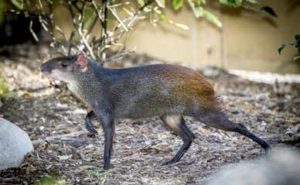 Sharing the habitat with our giant anteater are two adorable animals called red-rumped agoutis. They are brothers named Ren and Stimpy. Agoutis are rodents native to South America that resemble really large guinea pigs. They are the only animals capable of cracking open the tough outer shell of a Brazilian nut using just their teeth. You might see the agoutis at the zoo digging – they will bury their food for later, much like a squirrel!
Sharing the habitat with our giant anteater are two adorable animals called red-rumped agoutis. They are brothers named Ren and Stimpy. Agoutis are rodents native to South America that resemble really large guinea pigs. They are the only animals capable of cracking open the tough outer shell of a Brazilian nut using just their teeth. You might see the agoutis at the zoo digging – they will bury their food for later, much like a squirrel!
BLACK-CROWNED CRANES
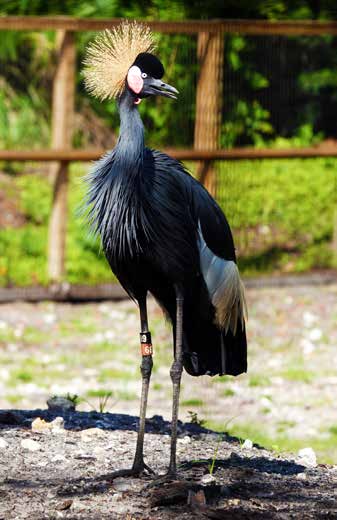 When guests see these birds, they often stop to stare at their beautiful and unique feather crown, but they may not know very much about this species. Black-crowned cranes are the national bird of Nigeria. These birds are monogamous and appear to mate for life. They perform elaborate dance displays to bond that include bowing, leaping, running, and more. We have two pairs at the zoo: Duck Duck and Goose live with mountain bongos, while Jerry and Elaine live with the sitatunga.
When guests see these birds, they often stop to stare at their beautiful and unique feather crown, but they may not know very much about this species. Black-crowned cranes are the national bird of Nigeria. These birds are monogamous and appear to mate for life. They perform elaborate dance displays to bond that include bowing, leaping, running, and more. We have two pairs at the zoo: Duck Duck and Goose live with mountain bongos, while Jerry and Elaine live with the sitatunga.
THE TORTOISES
Across from the red-rumped agoutis are two different tortoise habitats. One is the home 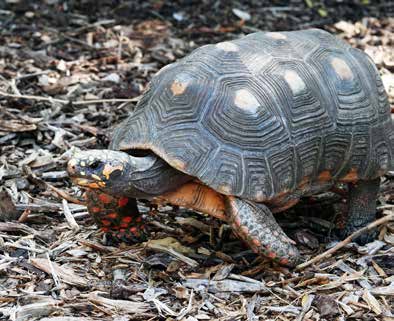 to red-footed tortoises and Aldabra tortoises. The other is the home to two gopher tortoises. Red-footed tortoises are native to Central and South America. We have three males named Larry, Moe, and Curly, after The Three Stooges! Sharing space with the red-footed tortoises are two Aldabra tortoises. Aldabra tortoises are truly amazing – they can live to be at least 100 years old and males can weigh over 500 pounds! While the gopher tortoises next door are a local species, they are still very important to see and learn about. Gopher tortoises are considered a keystone species (a species that is an indicator of ecosystem health) because they create burrows that are utilized by at least 350 other species. Florida Fish and Wildlife Conservation Commission (FWC) lists the gopher tortoise as Threatened. Both the tortoise and its burrow are protected under state law. Per FWC, gopher tortoises must be relocated before any land clearing or development takes place, and property owners must obtain permits from the FWC before capturing and relocating tortoises.
to red-footed tortoises and Aldabra tortoises. The other is the home to two gopher tortoises. Red-footed tortoises are native to Central and South America. We have three males named Larry, Moe, and Curly, after The Three Stooges! Sharing space with the red-footed tortoises are two Aldabra tortoises. Aldabra tortoises are truly amazing – they can live to be at least 100 years old and males can weigh over 500 pounds! While the gopher tortoises next door are a local species, they are still very important to see and learn about. Gopher tortoises are considered a keystone species (a species that is an indicator of ecosystem health) because they create burrows that are utilized by at least 350 other species. Florida Fish and Wildlife Conservation Commission (FWC) lists the gopher tortoise as Threatened. Both the tortoise and its burrow are protected under state law. Per FWC, gopher tortoises must be relocated before any land clearing or development takes place, and property owners must obtain permits from the FWC before capturing and relocating tortoises.
SITATUNGA
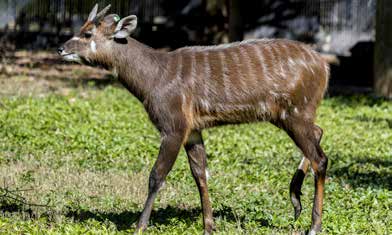 Sitatunga are a swamp-dwelling antelope native to Africa. Sitatunga are excellent swimmers – when threatened, they can go completely underwater leaving just their nose exposed. At Naples Zoo, we have three male sitatunga: Beau, Dallas, and Korben, who live across from our cheetah and hyena habitats. They all love playing in water and getting their horns dirty. Sitatunga also make a sqeak sound that sort of sounds like a frog, and Beau’s keepers say he loves to talk!
Sitatunga are a swamp-dwelling antelope native to Africa. Sitatunga are excellent swimmers – when threatened, they can go completely underwater leaving just their nose exposed. At Naples Zoo, we have three male sitatunga: Beau, Dallas, and Korben, who live across from our cheetah and hyena habitats. They all love playing in water and getting their horns dirty. Sitatunga also make a sqeak sound that sort of sounds like a frog, and Beau’s keepers say he loves to talk!
REEVE’S MUNTJAC
Reeve’s muntjac are a type of small deer native to China and Taiwan. These little guys can be found across from our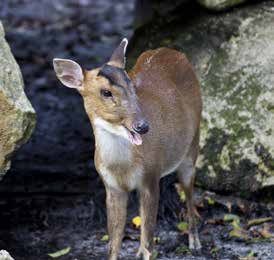
black bear and red-ruffed lemur exhibits. Although they are mainly herbivorous, they will sometimes eat meat! They’re known as the “barking deer” because they make a sharp barking sound, like a dog, when alarmed. This muntjac gets it common name from John Reeves, a British naturalist who lived in China in the early 19th century. Here at Naples Zoo, we have three females named Leah, Sarah, and Carrie, and one male named Tyler. You can tell Tyler apart because as a male, he is the only one with antlers. Look closely for these deer around the trees and bushes in their yard to find them!
We hope you visit to seek out these often overlooked animals on your next visit to Naples Zoo, read their exhibit signs, and learn something new.



Leave a Reply
Want to join the discussion?Feel free to contribute!